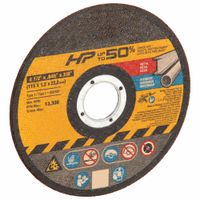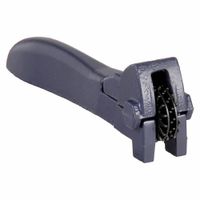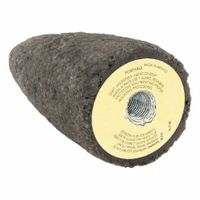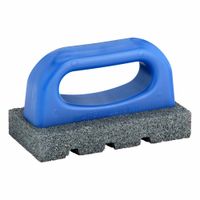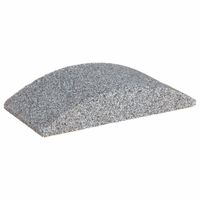Call +(254) 703 030 000 / 751 483 999 / 721 704 777
.....Read More
Frequently Asked Questions
What are the differences between cut-off wheels and grinding wheels?
Cut-off wheels and grinding wheels are both abrasive tools used with angle grinders or other power tools, but they serve distinct purposes due to their design and composition.
Cut-off wheels, also known as cutting wheels, are thin and designed for precision cutting of various materials like metal, concrete, or tile. They are typically made with a fiberglass mesh reinforcement for lateral strength, allowing them to make narrow kerfs and clean cuts. Their primary function is to slice through material. Using a cut-off wheel for grinding can be dangerous as the lateral pressure can cause the thin wheel to shatter.
Grinding wheels, in contrast, are thicker and designed for material removal, shaping, and smoothing. They are made from a denser abrasive material, often bonded with resin, and are built to withstand significant downward pressure. Their thicker profile allows for greater contact with the workpiece, making them effective for deburring, chamfering, sharpening, and surface preparation. While a grinding wheel can make a rough cut, it's not designed for efficient slicing, and attempting to cut deeply with it can generate excessive heat and wear.
In summary, the key differences lie in their thickness, reinforcement, and intended application: cut-off wheels are thin and reinforced for cutting, while grinding wheels are thick and designed for surface removal and shaping.
How do I choose the right abrasive wheel for my application?
Choosing the right abrasive wheel depends on several factors, including the material you're working with, the desired finish, and the type of grinding operation. Different materials require different abrasive grains: aluminum oxide is good for steel and ferrous metals, silicon carbide for non-ferrous metals and ceramics, and zirconia alumina for heavy-duty applications. The grit size determines the finish – coarser grits remove material quickly, while finer grits create smoother finishes. Bond types (vitrified, resinoid, rubber) affect the wheel's strength and how it releases abrasive grains, influencing performance and safety. Wheel diameter and thickness should match your machine and the job. Always consult the manufacturer's recommendations and safety guidelines for the specific abrasive wheel and application.
What safety precautions should be taken when using cut-off and grinding wheels?
When using cut-off and grinding wheels, it's crucial to prioritize safety. Always wear appropriate personal protective equipment (PPE), including safety glasses or a face shield, hearing protection, gloves, and a dust mask or respirator. Before starting, inspect the wheel for any damage, cracks, or imperfections; a damaged wheel can shatter and cause serious injury. Ensure the wheel is correctly mounted on the tool and that the guard is in place and properly adjusted to deflect debris away from you. Verify that the tool's RPM (revolutions per minute) does not exceed the maximum RPM rating of the wheel.
Maintain a firm grip on the tool and stand in a stable position. Never force the wheel into the workpiece, as this can cause the wheel to bind, kick back, or break. Allow the wheel to reach full operating speed before making contact with the material. Be aware of sparks and debris, ensuring they are directed away from flammable materials and other people. After use, allow the tool to cool down before storing it. Proper ventilation is also important to disperse dust and fumes. Always follow the manufacturer's instructions for both the tool and the abrasive wheel.
How do I properly install and use a cut-off wheel on an angle grinder?
To properly install and use a cut-off wheel on an angle grinder, always prioritize safety. First, ensure the angle grinder is unplugged. Select the correct cut-off wheel for your material and grinder's RPM rating, ensuring it is not damaged. Place the inner flange on the grinder spindle, then position the cut-off wheel on top, aligning it with the flange. Next, thread the outer flange or locking nut onto the spindle and tighten it securely using the spanner wrench provided with the grinder. Never overtighten.
Before use, always wear appropriate personal protective equipment (PPE), including safety glasses, hearing protection, gloves, and a dust mask. Position the material securely. Hold the grinder firmly with both hands, ensuring a stable grip. Start the grinder away from the workpiece and allow it to reach full speed before making contact. Apply steady, even pressure, letting the wheel do the work. Avoid forcing the wheel, as this can cause kickback or wheel breakage. Always cut in a direction that directs sparks away from you and others. After cutting, allow the wheel to stop completely before setting the grinder down. Regularly inspect the wheel for wear and replace it if it's damaged or too small to be effective.
What materials can be cut or ground with abrasive wheels?
Abrasive wheels are versatile tools used for cutting and grinding a wide range of materials. The type of material an abrasive wheel can effectively process depends on the abrasive grain used, the bonding agent, and the wheel's design.
Common materials that can be cut or ground with abrasive wheels include: * **Metals:** This is the most common application. Abrasive wheels are used on various metals like steel (including carbon, alloy, and stainless steel), cast iron, aluminum, brass, copper, and titanium. Different wheels are optimized for specific metal types; for instance, aluminum oxide wheels are often used for steel, while silicon carbide wheels are better suited for cast iron and non-ferrous metals.
* **Masonry and Concrete:** Specialized abrasive wheels, often containing silicon carbide or diamond particles, are used for cutting and grinding concrete, brick, stone (granite, marble, limestone), and other masonry products.
* **Ceramics and Glass:** Delicate and brittle materials like ceramics, porcelain, and various types of glass can be precisely cut or ground using abrasive wheels, particularly those with fine diamond or silicon carbide grits.
* **Plastics and Composites:** Certain abrasive wheels are designed to work with plastics, fiberglass, carbon fiber, and other composite materials, ensuring clean cuts and smooth finishes without melting or fraying.
* **Wood (to a lesser extent):** While not their primary use, some abrasive wheels with specific designs can be used for rough shaping or deburring wood, though more specialized woodworking tools are generally preferred.The key to successful cutting and grinding lies in selecting the appropriate abrasive wheel for the specific material and application.
How do I maintain and dress a grinding wheel?
Maintaining and dressing a grinding wheel are crucial for optimal performance, safety, and extending the wheel's lifespan.
Maintenance involves regular cleaning to remove accumulated grinding swarf and dust, which can clog the wheel's pores and reduce its cutting efficiency. A stiff brush or compressed air can be used for this purpose. Additionally, ensure the wheel is securely mounted and that the machine's guards are in place and properly adjusted before operation. Always inspect the wheel for any cracks or damage; a damaged wheel can be extremely dangerous.
Dressing is the process of exposing new, sharp abrasive grains on the wheel's surface and restoring its original geometric shape. Over time, grinding wheels can become loaded (clogged with material) or glazed (the abrasive grains become dull), both of which reduce cutting effectiveness and generate excessive heat. Dressing tools, such as diamond dressers or abrasive sticks, are used to remove the dulled or clogged layer.
When dressing, ensure the dresser is held firmly and at a slight angle to the wheel's rotation. Apply consistent, light pressure, traversing the dresser across the wheel's face from one side to the other. This process creates a fresh cutting surface, improves material removal rates, reduces heat generation, and ensures a more precise finish on the workpiece. Always wear appropriate personal protective equipment, including eye protection, during maintenance and dressing operations.
What are the common causes of abrasive wheel failure?
Abrasive wheel failures can stem from various factors, often categorized into improper use, manufacturing defects, and environmental conditions. One prevalent cause is exceeding the maximum operating speed (RPM) recommended by the manufacturer, leading to excessive centrifugal forces that can shatter the wheel. Improper mounting, such as overtightening the wheel, using incorrect flanges, or failing to use blotters, can induce stress and cause breakage. Dropping or striking the wheel can create invisible cracks that propagate during operation, resulting in sudden failure. Using a wheel for an application it wasn't designed for, like side grinding with a wheel intended for cutting, can also lead to catastrophic failure. Manufacturing defects, though less common with reputable brands, can include imbalances, inconsistencies in bonding material, or internal flaws. Lastly, exposure to extreme temperatures, humidity, or corrosive materials can degrade the wheel's integrity over time, making it susceptible to failure. Adhering to safety guidelines, proper storage, and regular inspection are crucial to preventing these failures.
How do I know when to replace a cut-off or grinding wheel?
Cut-off and grinding wheels should be replaced when they are worn down to their minimum diameter, which is typically specified by the manufacturer. They should also be replaced if they are cracked, chipped, or otherwise damaged, as this can lead to catastrophic failure during use. Another important indicator is if the wheel is no longer cutting efficiently or is generating excessive heat, which can be a sign of a dull or glazed surface. Always inspect the wheel for any signs of damage before each use and ensure it is properly mounted on the tool. Using a damaged or worn wheel can be extremely dangerous and lead to serious injury.
What are the best practices for storing abrasive wheels?
To ensure the safety and longevity of abrasive wheels, proper storage is crucial. Store wheels in a dry, cool, and well-ventilventilated area, away from extreme temperatures, humidity, and direct sunlight. Excessive moisture can weaken the bond of the wheel, while extreme heat can alter its structural integrity.
Abrasive wheels should be stored on racks or in bins that support their full diameter to prevent warping or damage. Flat wheels, such as straight wheels, should be stored on their edges, while cup wheels and tapered wheels should be stored on their faces. Avoid stacking wheels on top of each other, especially if they are of different sizes or shapes, as this can lead to uneven pressure and potential breakage.
Protect wheels from impact and physical damage by storing them in their original packaging or in protective containers. Clearly label storage areas with the wheel type, size, and abrasive material to ensure correct selection and usage. Regularly inspect stored wheels for any signs of damage, cracks, or discoloration before use. Damaged wheels should be immediately discarded. By following these best practices, you can maintain the quality and safety of your abrasive wheels, ultimately extending their lifespan and ensuring efficient performance.
How do I troubleshoot issues with cut-off and grinding wheels?
Troubleshooting issues with cut-off and grinding wheels often involves identifying common problems related to wheel integrity, machine setup, and operator technique.
For cut-off wheels, common issues include premature wear, wheel breakage, and poor cutting performance. Premature wear can be caused by excessive pressure, using the wrong wheel for the material, or a worn machine spindle. Wheel breakage is a serious safety concern and can result from cracks in the wheel, improper mounting (over-tightening or under-tightening), or side loading the wheel during operation. Poor cutting performance might indicate a glazed wheel, an incorrect wheel type, or insufficient machine power.
Grinding wheels can experience issues like glazing, loading, wheel chatter, and excessive vibration. Glazing occurs when the abrasive grains become dull, leading to a smooth, shiny surface that won't cut effectively. This often happens with too much pressure or using too hard a wheel. Loading refers to workpiece material getting embedded in the wheel's pores, reducing its cutting efficiency. This can be caused by using too soft a wheel, an inappropriate coolant, or grinding soft, gummy materials. Wheel chatter and excessive vibration can stem from an unbalanced wheel, worn machine bearings, improper wheel mounting, or an unstable work setup.
To troubleshoot, always start by inspecting the wheel for damage. Ensure it's the correct type and size for the application and mounted securely. Check the machine for proper RPM, spindle run-out, and overall stability. Finally, review operator technique for consistent pressure, proper feeding rates, and correct wheel orientation. Addressing these points systematically will help resolve most cut-off and grinding wheel issues.

